
I also wonder whether – for a work of this size – it might not have been wiser to bring in a composer with a more developed symphonic practice. A richer and more varied score may well have suggested a wider variety of movement options.
Nonetheless, for all its flaws, this might be the company’s most interesting Australian commission since Alice Topp’s Little Atlas – and that was almost 10 years ago.
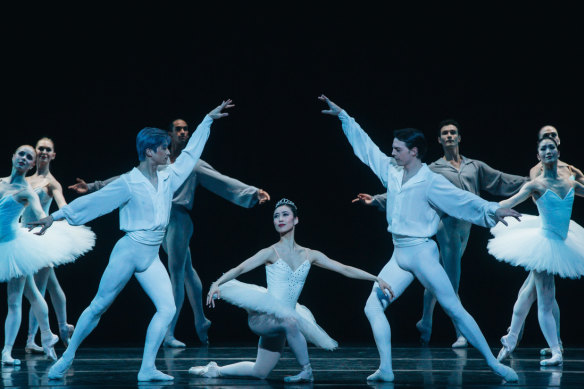
Circle Electric is paired with Études, Harald Lander’s 1948 rhapsody on classroom barre exercises.Credit: Kate Longley
The second work of the evening is Études, Harald Lander’s 1948 rhapsody on classroom barre exercises, a whimsical exhibition piece designed to show off a company’s mastery of the academic vocabulary.
The piece has charm but doesn’t work as a companion to Circle Electric. The publicity material speaks hopefully of a productive “collision of worlds”. In fact, there’s little to be said about the contrast. The two works barely connect.
It’s only during the famous flying scene, where dancers perform split leaps in a cross of two strips of light, that productive comparison seems possible: a cross imposed upon a nought, the negation of all that generous circularity.
The company nonetheless performed with justified confidence. Ako Kondo, as la reine de la danse, was in excellent form on opening night, as were her principal gallants, Chengwu Guo and Joseph Caley.
Reviewed by Andrew Fuhrmann
THEATRE | FRINGE FESTIVAL
Transmission – into the dark ★★★★
One step at a time like this, The Substation, until October 5
The metaphysical idea of theatrum mundi invokes the great stage of the world, with our lives experienced as performance. Some version of it has permeated philosophy since at least Plato’s allegory of the cave. The flip side of the notion is, of course, that artists can dismantle theatrical conventions and blur neat distinctions between art and life; they may use anywhere they like as a stage.
Transmission – into the dark – the latest work from experimental performance outfit One Step at a Time Like This – uses the inner-west suburb of Newport. It draws upon cutting-edge technology and knowledge much older than Plato’s, and seems geared towards unfurling the nature of consciousness itself, which would seem to cast attendees as both actor and audience, participant and spectator.
Starting at a secret location, the piece begins with an audio-guided night walk through suburban streets, and meanders into a spectacular digital performance installation, before following a trail to the stars.
The effect of this site-responsive, tech-augmented experience is to encourage reflection on self and place and one’s place in the world.
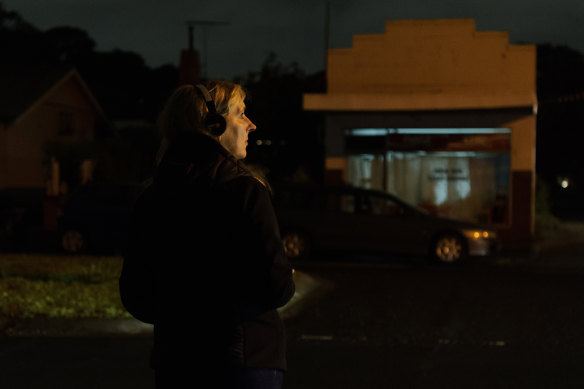
Transmission is a show that turns the world into a stage.Credit: Sarah Walker
At first, I thought of Tamara Saulwick’s Newport Archives, an audio tour of the suburb’s working-class history, and how completely gentrified Newport has become since 2019.
As I caught the indescribable whiff of the power station (the smell of clutter, I suppose), I reflected on disjunctions in sensory perception: this was an invisible, purely olfactory boundary, the properties remaining as genteel and immaculately manicured either side of it.
Loading
I thought of how your walking changes when you think about how you’re walking. Of Thomas Bernhard’s novella about walking and thinking. Of the impossibility of true self-reflection. Of the stickiness of tradition, and curtains within curtains in the theatre of the mind. Of how differently we must think to understand the impossibly tiny and the incredibly vast – across human history, as much as theoretical physics.
To provoke deep thinking is perhaps the one constant in the group’s eclectic oeuvre, which includes everything from Since I Suppose, an embedded urban walking tour inspired by Shakespeare’s Measure for Measure, to the live-art experience Carnival of Futures, an inventive sideshow-cum-seminar exploring how we perceive, imagine and relate to possible futures for humanity.
So, no spoilers here. Surprise is key to this meditative night odyssey, which should stand to be judged by the quality of thought it inspires in you.
Reviewed by Cameron Woodhead
This review was written from a preview performance.
MUSIC
Concertante ★★★★
Omega Ensemble, Melbourne Recital Centre, October 1
Blessed by young, talented musicians, the Omega Ensemble continues to prove itself a vital part of this country’s musical landscape with its commitment to nurturing new Australian chamber music.
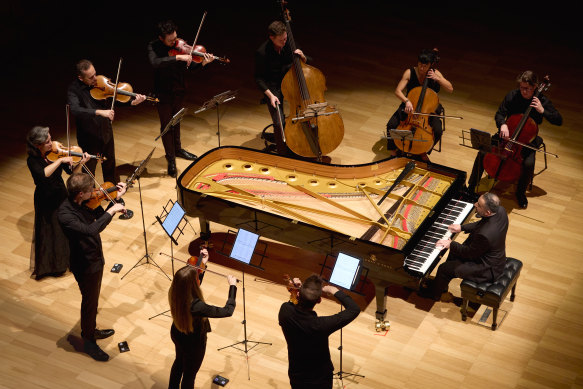
Omega Ensemble perform at Melbourne Recital Centre on October 1, 2024.Credit: Laura Manariti
Nonetto II by Finnish conductor, pianist and composer Olli Mustonen gave Omega’s latest program an edgy opening. This shape-shifting music, cast in four short movements, hinted at Bernard Herrmann’s abrasive score for Alfred Hitchcock’s Psycho before morphing into Beethovenian gestures leavened at times with a dash of Schubertian repose. Led energetically by principal violin Peter Clark, the effervescent, lightning-fast finale formed a perfect foil to the preceding meditative adagio.
Commissioned by Omega and receiving its first performance, Harry Sdraulig’s Triptych was a well-crafted vehicle for the prodigious skills of clarinettist David Rowden. Inspired by the art of Australian painter Clarice Beckett, the score’s initial scene, Sea Drift, allowed undulating patterns to support the rise and fall of soloistic musical waves. Muted strings endowed The Garden with a misty pastoralism, leading eventually to an impassioned soliloquy to which Rowden brought all his expressive powers. Mystic Dance was a joyful interplay of rhythmic and timbral elements that culminated in exultant, high clarinet exclamations fearlessly delivered.
Attempting to recreate something of the chamber ambience in which Chopin’s piano concertos were initially performed, the account of his Piano Concerto No. 1 with soloist Vatche Jambazian accompanied by nine string players would have been improved with the use of a historically appropriate piano. Both the size of the hall and the use of a brilliant and powerful Steinway concert grand worked against musical cohesion. Even so, Jambazian used his undoubted pianistic credentials to create plenty of poetry, particularly in the melting, central Romanze, surrounding it with exciting technical pyrotechnics.
A welcome encore, Arvo Part’s calming Fur Alina restored balance to the evening’s eclectic but accomplished music-making.
Reviewed by Tony Way
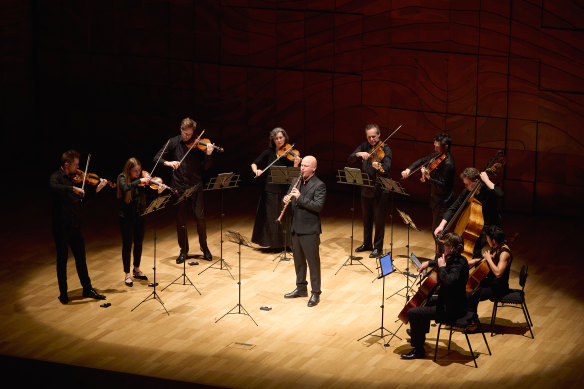
Harry Sdraulig’s Triptych was a well-crafted vehicle for the prodigious skills of clarinettist David Rowden.Credit: Laura Manariti
THEATRE | FRINGE FESTIVAL
Bad Boy ★★★★
fortyfivedownstairs, until October 13
“Luvya tits! Luvya tits!” cries the pint-sized ringmaster, broadcasting his coarse lust at the start of Patricia Cornelius’ Bad Boy. It’s “Roll-up! Roll-up!” retuned in an aggressive, misogynistic key, and on opening night, spectators to this little circus soon found the ringmaster doubling as clown.
I don’t know if it was intentional, but performer Nicci Wilks’ false moustache kept slithering from her lip, and not even her highly trained dexterity – Wilks’ career began at the Flying Fruit Fly Circus – could stop it from dropping pathetically to the floor.
A moment of “Insecure masculinity … ta-dah!” to undermine the demeaning barrage was thematically perfect for a work that sees Wilks, playwright Cornelius, and director Susie Dee rejoin forces to explore domestic violence.
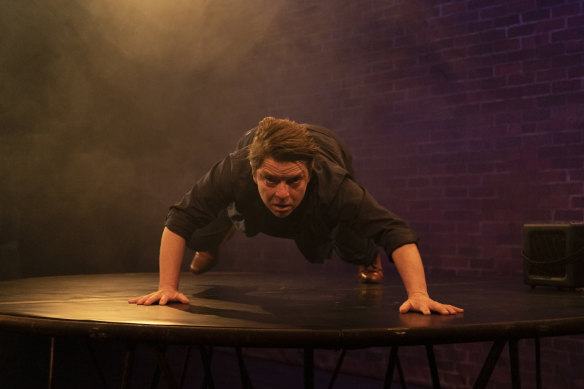
Nicci Wilks performs with a sharp comic touch and empathic scrutiny.Credit: George Jefford
Their last collaboration, Runt, embodied the psychology of abjection, cruelty and powerlessness through condensed monologue and heightened physical theatre. This one feels like a natural extension.
Gender is in the hot seat here, and within minutes Wilks has stripped off the greasepaint to get under the skin of a small man who needs women to be smaller still.
This is a love story. A romance. We all know it – the disturbing lyrics of popular love songs (The Police’s creepy Every Breath You Take is just the beginning) scroll above the action.
And Wilks’ character feels it – he’s genuinely smitten by his new girlfriend, even as the relationship slides (and there’s a sickening inevitability to how ‘normal’ Bad Boy makes the trajectory seem) into coercive control and eventually physical violence.
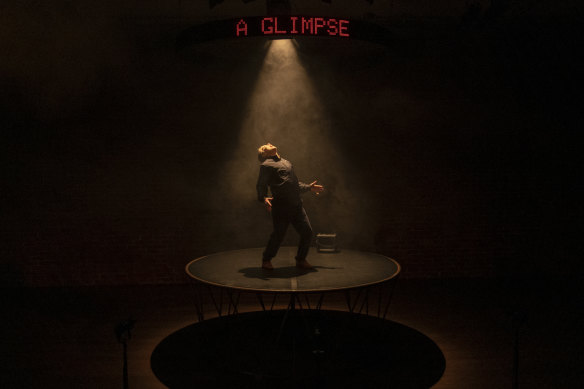
Nicci Wilks gives a bravura performance in Bad Boy.Credit: George Jefford
Wilks inhabits this frustrated figure with a sharp comic touch and empathic scrutiny. She’s so convincing as a bloke, she might fool those who don’t know her gender, though those who do will discover moments of dramatic equivocation far deeper than a wayward moustache or the hilariously extended pissing contest he has with himself.
Wilks can silently reflect the agony of the woman to whom the play gives no voice. When the man has a flicker of transient insight into his behaviour – horrified by what he’s done – we see the terror mirrored in his victim’s prone body, too.
Peppered with clowning, break-dancing, karaoke and spoken word with a spotlight on the everyman, Bad Boy channels variety performance to illustrate the nexus between social, psychological and cultural contributors to domestic violence and the plausibly imagined individual experience of a perpetrator.
Loading
Perhaps Cornelius’ script is distilled to the point of under-realisation on occasion, but that just gives greater focus to Wilks’ bravura performance, and the clarity of Dee’s direction in framing a problem that implicates our whole society.
Reviewed by Cameron Woodhead
THEATRE
Pride and Prejudice: An Adaptation in Words and Music ★★★★
Arts Centre Melbourne, until October 6
Every Janeite will rejoice at the prospect of seeing Nadine Garner in Pride and Prejudice. This is such a pleasant and accessible adaptation, it’ll appeal to lovers of Jane Austen’s pop-cultural descendants, too, especially Bridgerton watchers and readers who haven’t traced their fandom back to its literary source.
We’re transported to Regency England through music. Madeleine Easton on violin and Daniel Le on piano first play an excerpt from Carl Davis’ score for the 1995 BBC adaptation, starring Jennifer Ehle and Colin Firth, before launching into virtuosic renditions of that composer’s classical influences.
A Schubert sonatina, Beethoven’s first sonata for piano and violin, plus a side-serve of Regency dance music: if you don’t know what a quadrille sounds like, or a Scottish reel, you will after this.
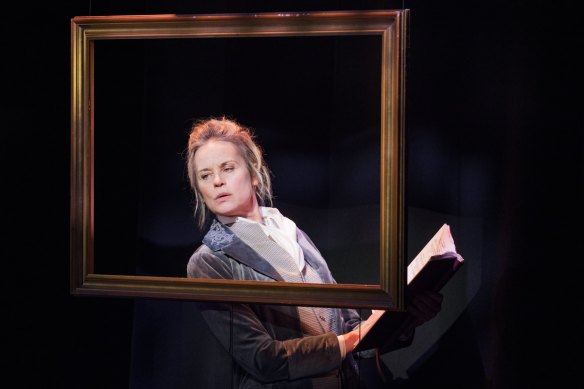
Nadine Garner as the narrator in Pride and Prejudice – An Adaptation in Words and Music.Credit: Robert Catto
True, some of Easton’s remarks on Austen’s importance sound fatuous and need polishing – incorporating the author’s own music collection, as they did at La Mama in By Jane’s Hand, might work. And arguably the purely musical section of the evening could be usefully split between a shorter intro and a brief interlude midway through the storytelling.
But no one will care about that in the presence of Garner, whose lively staged narration, delivered in a fine Regency frock coat, draws out the essence of Austen’s most popular novel, which hasn’t been out of print since it was first published (anonymously) in 1813.
Garner delights in conspiring with the audience to unleash Austen’s ironic wit and rather acerbic observations of character and society.
Occasional dialogue swells into caricature on command, and droll physical comedy offers a nod and a wink to what’s going on underneath all that period costume, in a performance as expressive and expansive as Gill Hornby’s text is highly compressed.
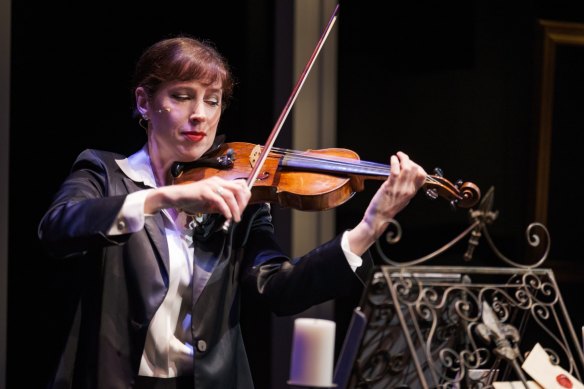
Madeleine Easton helps transport the audience to Regency England through music.Credit: Robert Catto
Austen aficionados might miss some of the author’s intricacies, and some supporting characters get short shrift, but this isn’t a show that simply delivers a precis of the plot.
Rather, it emphasises Elizabeth Bennet’s prejudice and Mr Darcy’s pride, and the contentions and follies – some personal, some social – strewn across their road to romance.
Loading
It leans into the Shakespearean sense of the perversity of human nature that Austen possessed (and an inside eye on the lived experience of women that Shakespeare lacked).
Tyran Parke’s direction has mastered the difficult feat of combining spoken word and near constant musical accompaniment without distracting from either. And if this Pride and Prejudice isn’t so profound a literary engagement as, say, Miriam Margolyes’ Dickens’ Women, Garner’s performance is as skilled, and it’s just as much fun.
Reviewed by Cameron Woodhead
This review was written from a preview performance.
The Booklist is a weekly newsletter for book lovers from Jason Steger. Get it delivered every Friday.









 Add Category
Add Category